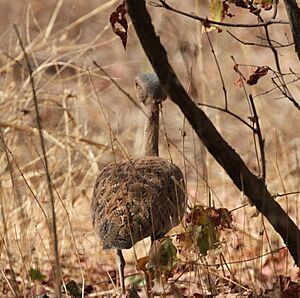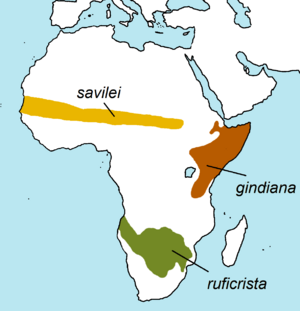Savile's bustard facts for kids
Quick facts for kids Savile's bustard |
|
|---|---|
 |
|
| Conservation status | |
| Scientific classification | |
| Genus: |
Lophotis
|
| Species: |
savilei
|
 |
|
| Range of Lophotis savilei | |
The Savile's bustard (Lophotis savilei) is a type of bird belonging to the Otididae family. These birds are mostly found in parts of Africa. You can find them in countries like Burkina Faso, Cameroon, Chad, Ivory Coast, Gambia, Mali, Mauritania, Niger, Nigeria, Senegal, and Sudan.
Contents
What Does the Savile's Bustard Look Like?
Adult Savile's bustards have short, thin necks and legs. They also have a fairly large head. The top of their head and the front of their neck are grey. A black stripe runs down the middle of their chin. They also have a small white stripe on each shoulder.
Their upper body is pale with black stripes and arrow-shaped marks. Their beak is yellowish, and their eyes are a pale, speckled clay color. Their feet are also yellowish. Their wings are about 25 centimeters (10 inches) long. Their tail is about 13 centimeters (5 inches) long. The ends of their feathers are light beige. This makes their feather shafts look different from the rest of their body. Their flight feathers are dark with thin beige stripes. The very tips are black.
How Do Males and Females Differ?
Male Savile's bustards have completely black underparts. During mating season, they show a tuft of reddish-brown feathers on the back of their neck. Female bustards look similar to males. However, they do not have the blue-grey and black marks on their head. Females have a white throat. Their black underparts are only on their belly.
Where Do Savile's Bustards Live?
Savile's bustards live in dry and semi-dry areas. These are often called "hotspots" for bustard species. They prefer living in bushes and light woodlands. You might find them near dry pools and open areas. They also like flat shrubs with certain types of grass and acacia trees. This is similar to other birds in the Otididae family. These birds usually live in dry grasslands in warm and tropical areas.
You can find the Savile's bustard across a wide area. This includes southwest Mauritania and Senegal. Their range extends east through Mali, Burkina Faso, and southwest Niger. They are also found in northeast Nigeria, Chad, and central Sudan. People once thought they only lived in the Sahel region. But now they have been seen moving further south.
How Do Savile's Bustards Behave?
What Sounds Do They Make?
The Savile's bustard has a clear and unique call. It sounds like a whistled tuit thit. Males make special calls when they are trying to attract a mate. They produce a short whistle. This is followed by a series of faster whistles. It sounds like tuit! tutututututututut. They can also make frog-like sounds in the same rhythm.
What Do Savile's Bustards Eat?
Scientists don't know much about what Savile's bustards eat. However, they have been seen eating Senegalese Grasshoppers in Senegal. This shows they are important predators for these insects.
How Do They Move Around?
Savile's bustards usually stay in one place. They are mostly sedentary. But during the dry season (December to May), they sometimes move. In Park W in Niger, they move north out of Nigeria when it rains. They do this to find places to breed. When they do move, they travel alone or in pairs. They are quite secretive birds. They don't fly very often, and only for short distances. If they want to avoid predators, they will freeze and stay very still.
Are Savile's Bustards in Danger?
The Savile's bustard is listed as a species of "least concern" by the IUCN Red List. This means their population is stable. They are not considered threatened. This is because they have a large range and a fairly high number of birds. There is also no clear evidence that their numbers are dropping. They seem to be quite common in the Yankuri Game Reserve in Nigeria.
Even though this species is stable, many other bustard species are in trouble. Their populations are declining. This is due to changes in farming, too much grazing by animals, hunting, and trapping. Losing their habitat and droughts also threaten them.


